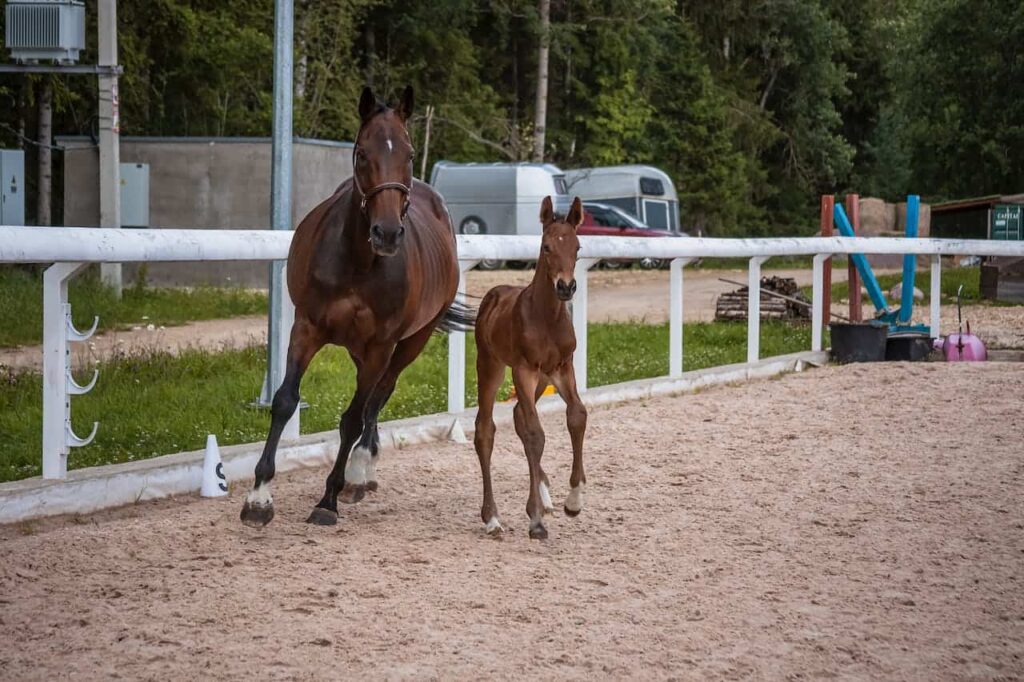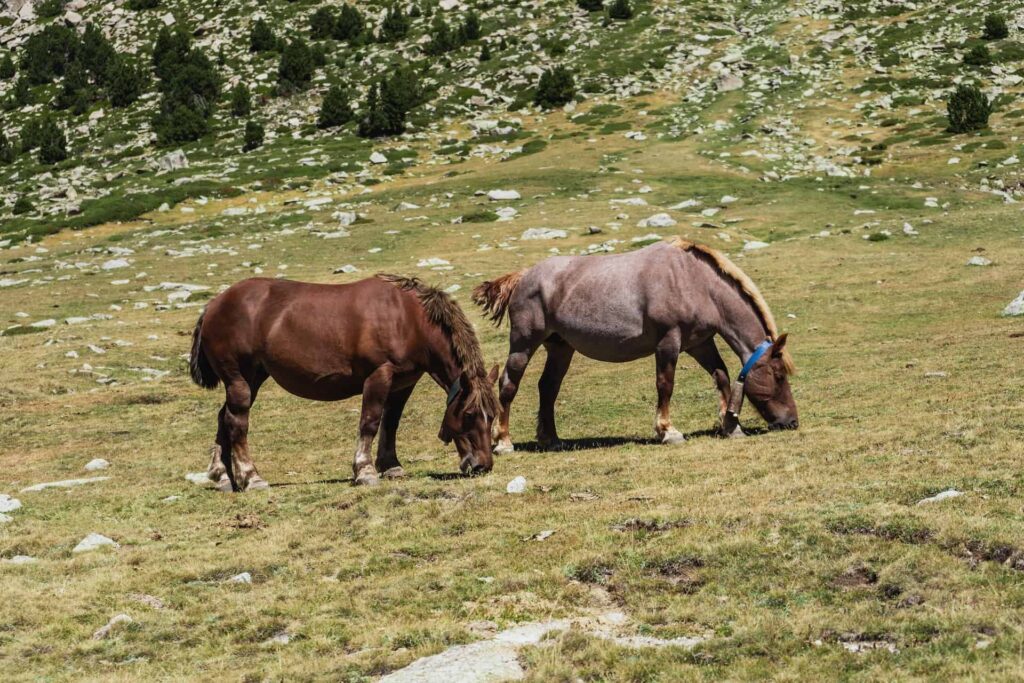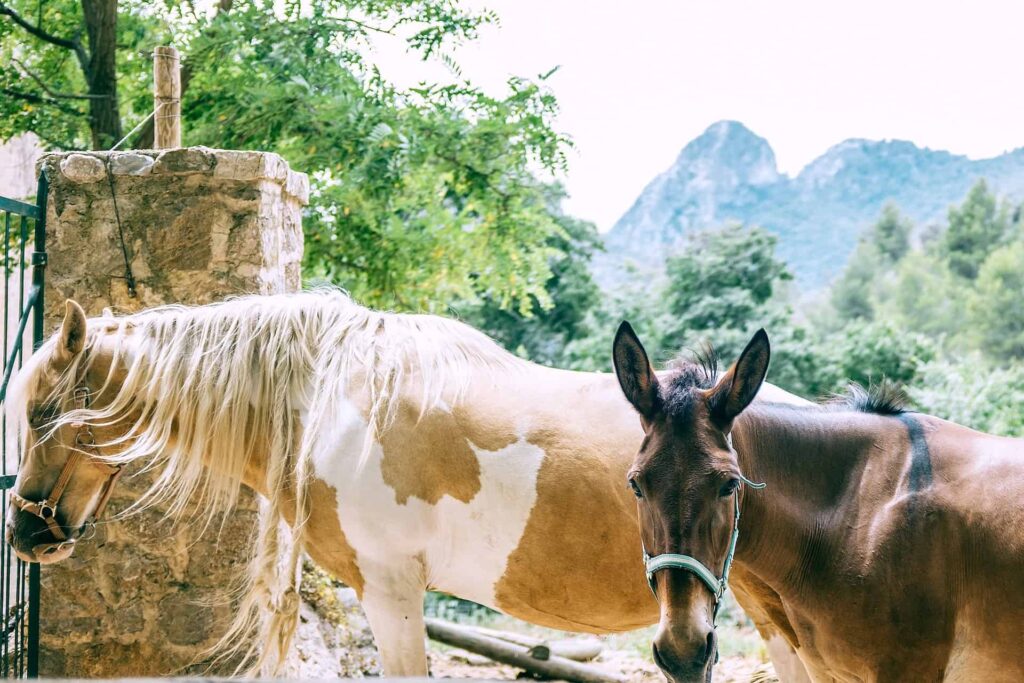Gaited horses are known for their smooth manner of walking and trotting, making them especially popular for riding. These horses possess a natural ability to perform distinct gaits that set them apart from other horse breeds. Gaited horses are loved by many riders for their gentle, easygoing demeanor and their aptitude for providing a comfortable ride, especially over long distances.
One of the main reasons gaited horses stand out is their ability to perform smooth rhythms, often referred to as ‘easy gaits’. These gaits are characterized by a consistent footfall pattern that differs from the typical walk, trot, and canter of non-gaited horses. While there are numerous breeds of gaited horses and a variety of types of gaits, the primary commonality between them is their natural ability to provide a pleasant riding experience for their riders.
Key Takeaways
- Gaited horses are known for their smooth manner of walking and trotting which make them popular for riding.
- They possess a natural ability to perform distinct footfall patterns that set them apart from other horse breeds.
- The various breeds and types of gaits focus on providing a comfortable, enjoyable ride for their riders.
Understanding Gaited Horses
Gaited horses are known for their unique, smooth gaits that provide a comfortable ride for the rider. These naturally gaited horses have the ability to perform gaits other than the typical walk, trot, and canter seen in non-gaited breeds. The smoother gaits result from variations in the sequence and timing of footfalls, which contribute to the comfort of the rider.
There are several naturally gaited horse breeds, each with its distinctive set of gaits. Some popular breeds include the Tennessee Walking Horse, Missouri Foxtrotter, and Icelandic Horse. While these breeds differ in appearance and origin, their smooth gaits set them apart from other breeds.
The smooth gaits of gaited horses are attributed to genetics. A dominant gene called the dmrt3 gene has been identified as responsible for the unique gaits seen in these breeds. This gene affects the coordination and timing of leg movements, resulting in distinctive gaits.
Beyond providing a comfortable ride, gaited horses are often prized for their versatility in various disciplines such as trail riding, endurance riding, and show events. The unique gaits and natural ability to perform them without extensive training make gaited horses a popular choice among horse enthusiasts.
Gaited horses are a group of horse breeds that possess unique, smooth gaits due to the presence of a dominant gene. These naturally gaited breeds offer a comfortable ride and are valued for their versatility across different equestrian disciplines.
Breeds of Gaited Horses
Gaited horses are known for their unique, smooth gaits that provide comfortable rides for their riders. There is a wide variety of gaited horse breeds, each with their own distinct characteristics.
The Tennessee Walking Horse is a popular breed from the United States, revered for its smooth “running walk” gait. Its graceful strides and versatility make it suitable for both leisurely trail rides and show competitions.
The Icelandic Horse is a small yet strong breed originating from Iceland. With their gentle temperament, they are great for families and beginners. Their distinct gait, the tölt, provides an exceptionally smooth ride even at fast speeds.
Paso Fino horses, originating from Latin America, are prized for their unique and remarkably smooth “paso” gaits. Their elegant presence and natural rhythm make them incredible performers in horse shows.
The Rocky Mountain Horse is another American breed known for their natural ambling gait called the “single foot.” This sure-footed and agile breed is perfect for traversing rough terrain in the Appalachian Mountains.
American Saddlebred horses are known for their high-stepping, showy gaits. This athletic and spirited breed boasts of its good disposition and versatility in both pleasure riding and high-performance events.
The Morgan Horse is a versatile and hardy breed often used in various disciplines including dressage, western riding, and driving. Morgans can also perform an ambling gait called the “rack,” providing a comfortable riding experience.
Other prominent gaited breeds include the Standardbred, Missouri Fox Trotter, Peruvian Paso, Racking Horse, Kentucky Mountain Saddle Horse, Aegidienberger, and several others. Each of these breeds contributes to the diverse world of gaited horses, catering to different riders’ needs and preferences.
Some breeds, such as the Quarter Horse, Appaloosa, and Arabian, are not always considered gaited horses, but certain individual horses within these breeds may display gaited tendencies. Some crossbreeds like the Walkaloosa, Campeiro, Florida Cracker Horse, and Plantation horses exhibit gaited traits unique to their heritage.
The world of gaited horses is diverse and fascinating, with many breeds offering comfortable, smooth gaits suitable for various riding disciplines and preferences.
Related: How Many Breeds of Horses Are There?

Types of Gaits
Gaited horses are known for their unique and smooth ways of moving, which makes them comfortable to ride. There are several different types of gaits that horses can perform, ranging from the common walk and trot to more specialized ambling gaits. Let’s explore some of these.
The walk is a four-beat gait in which each hoof touches the ground independently. This slow and steady movement is the foundation for all other gaits. The trot is a two-beat gait where diagonal pairs of legs move together, creating a rhythmic and energetic motion.
A notable four-beat gait is the running walk, which is the distinctive gait of the Tennessee Walking Horse. It was initially a plantation gait and is smooth, with longer strides than the normal walk. Another popular four-beat gait is the tölt, which is characteristic of Icelandic horses. The tölt is known for its smoothness and speed, making it comfortable for long distances.
The canter and gallop are faster three-beat and four-beat gaits, respectively, where the horse’s legs move in coordinated sequences, providing greater speed and agility. The pace is a lateral two-beat gait where the horse moves its legs on the same side together. The rack is another four-beat gait that is smooth and fast, often seen in Saddlebred horses.
Among ambling gaits, there is a variety of smooth, four-beat rhythms. Some examples include the fox trot, performed by the Missouri Fox Trotter, and the single-foot, exhibited by the Rocky Mountain Horse. Ambling gaits differ in the sequence and timing of footfalls, providing distinct sensations and smoothness for riders.
Paso Fino horses are famous for their unique lateral gaits like paso corto and paso largo. These gaits are smooth and fast, with the horse’s legs moving in lateral pairs. Similarly, the sobreandando is another lateral gait that can be seen in the Peruvian Paso breed.
The marcha batida, trocha, and pasitrote are examples of ambling gaits found in the Mangalarga Marchador breed. These gaits are characterized by diagonal support phases, making them more stable and comfortable for riders.
Understanding the various types of horse gaits can help riders to better comprehend their horse’s movement and select a suitable gaited breed for their needs. Each gait has its own characteristics, providing unique experiences and advantages for both horse and rider.
Training Gaited Horses
Training gaited horses requires a unique approach as these horses possess the ability to perform smooth, distinct gaits that differ from the typical walk, trot, and canter. The key to proper training lies in understanding their natural abilities and potential for a comfortable ride.
Gaited horses possess their unique gait abilities due to selective breeding over generations. This has resulted in distinct breeds, such as the Tennessee Walking Horse, Paso Fino, and American Saddlebred, showcasing smooth, easy-to-ride gaits that are highly desirable for riding and show purposes. Although these gaits are naturally present in the breed, it is still necessary to train a gaited horse to enhance and refine their innate skills.
Training gaited horses typically begins with basic groundwork exercises, focusing on building trust, respect, and communication between the handler and the horse. This foundation is crucial for the horse to develop a balanced and relaxed state when ridden, ensuring optimal performance in their specialized gaits.
When riding a gaited horse, it is necessary to use specific tack that caters to the horse’s unique movements. Special saddles designed for gaited horses often feature a more flexible tree and longer bars, which allows for greater freedom of movement in the horse’s back and encourages a smooth gait. Proper saddle fit is critical for maintaining correct gait mechanics.
As the rider progresses with the training, they should focus on encouraging the horse’s natural gait through cues and aids, such as rein adjustments, seat position, and leg pressure. Employ gentle, humane methods that enhance the horse’s gait without causing resistance or discomfort.
As with any horse training, patience and consistency are vital components for success. Developing the horse’s unique gaits to their fullest potential requires time, understanding, and a customized training approach tailored to each horse. By dedicating time to refining a gaited horse’s natural abilities, both horse and rider can enjoy the benefits.
Gaited Horses in Action
Gaited horses are well-suitable for various equestrian activities. These horses have a natural ability to perform smooth gaits, which provide a pleasurable riding experience for both beginners and experienced riders alike. Here are some activities where gaited horses excel.
One of the most popular activities for gaited horses is trail riding. Due to their gentle and easy-going nature, these horses can navigate uneven terrain with ease, allowing riders to enjoy a comfortable and enjoyable ride. Their sure-footedness and endurance make them ideal for traversing long distances and handling various challenges that may be encountered on the trails.
Gaited horses also perform well in the show ring. Their unique gaits, such as the running walk, rack, and fox trot, are visually appealing and make them stand out in competitions. Judges often appreciate the gracefulness and fluidity these horses exhibit in their movements, rewarding their elegance and excellent performance in the show ring.
Long-distance riding is another area where gaited horses excel. Their stamina and ability to maintain a steady pace over extended periods make them highly suitable for endurance events. Their smooth gaits cause less stress on the rider’s body, allowing equestrians to cover great distances without experiencing discomfort or fatigue.
While gaited horses might not be considered the top choice for jumping events, their natural athleticism and adaptability enable them to perform respectably in low to moderate jumping activities. Some gaited horse breeds, such as the Icelandic Horse, have been known to display impressive jumping abilities, making them competitive in certain jumping disciplines.
Gaited horses offer a versatile and comfortable riding experience. Their naturally smooth gaits and adaptable nature make them suitable for a diverse range of activities, from trail riding and show ring performances to long-distance riding and jumping events. This unique combination of attributes has made gaited horses a popular choice for equestrians around the world.
Characteristics of Gaited Horses
Gaited horses are a popular choice for riders of all skill levels. They exhibit natural gaited tendencies, often resulting from specific genetic traits or gene mutations. These horses excel in stamina and endurance, making them well-suited for long trail rides and various equestrian activities.
One characteristic of gaited horses is their gentle demeanor. They tend to have a calm and cooperative attitude, making them easy to ride and handle. This characteristic is particularly beneficial for beginner riders or those who require a more easy-going experience. Gaited horses are often described as surefooted, providing a stable and secure ride on various terrains.
Gaited horses also have a high head carriage, which is a signature feature of several gaited breeds. This trait contributes to their elegant and distinctive appearance. Several gaited breeds, such as the Paso Fino horse, are known for unique gaits like the Paso llano and terminal. These slow gaits provide the rider with a smooth and steady ride.
The ability to perform slow gaits is an important feature of gaited horses. Not only do these natural rhythms enhance the riding experience, but they also contribute to the horse’s stamina and endurance. This combination of factors makes gaited horses an ideal choice for riders who require a mount capable of covering long distances at a steady pace.
Gaited horses possess a gentle demeanor, high-head carriage, and sure-footedness. Their natural gaited tendencies provide riders with an enjoyable and reliable mount, capable of both endurance and elegance.

What Makes a Gaited Horse Unique
Gaited horses are known for their unique, comfortable gaits that set them apart from other breeds. These horses perform lateral ambling gaits, which are smooth and rhythmic. This is in contrast to the traditional trot, which can be bouncy and jarring.
The Spotted Saddle Horse is one such breed known for its exceptional gaited abilities. This breed is characterized by its distinctive color patterns and smooth, easy-to-ride gait. The Spotted Saddle Horse typically performs a four-beat lateral ambling gait, providing a consistent footfall pattern that results in a smooth and stable ride.
Gaited horses perform a range of alternative lateral gaits, which can differ from one breed to another. Some of these gaits include the pleasure gait, single-footed gait, and the running walk. These gaits are achieved through variations in the timing and sequence of footfalls.
The pleasure gait is a specific type of gait that focuses on the comfort of the rider, prioritizing a smooth and steady movement. This gait is typically performed at moderate speeds, making it highly suitable for recreational riding and endurance events.
On the other hand, the single-footed gait is a faster gait that sees the horse placing only one foot on the ground at a time, providing a swift and agile movement. This gait is commonly seen in breeds like the Tennessee Walking Horse, offering a unique riding experience compared to the typical gaits of other breeds.
Gaited horses are unique due to their ability to perform smooth lateral ambling gaits that provide increased comfort and stability for the rider. These gaits, such as the pleasure gait, single-footed gait, and the distinctive movement of the Spotted Saddle Horse, continue to be an element of what makes these horses special and highly sought after by riders seeking a smooth and enjoyable riding experience.
Frequently Asked Questions
What are the key differences between gaited and non-gaited horse breeds?
Gaited horses are breeds that naturally perform smooth, four-beat ambling gaits, whereas non-gaited horses exhibit standard gaits such as walk, trot, canter, and gallop. Gaited horses are known for their comfortable ride and smooth transitions between gaits, making them suitable for long-distance riding.
What are the main benefits of riding a gaited horse?
Riding a gaited horse has several benefits, such as reduced rider fatigue and increased comfort while riding. Gaited horses offer a smoother ride compared to non-gaited horses, as their ambling gaits allow for reduced bouncing and impact, making them ideal for those with physical limitations or long-distance riders.
How does riding a gaited horse differ from riding a non-gaited horse?
Riding a gaited horse requires different techniques and cues compared to riding a non-gaited horse. The rider needs to be more aware of the horse’s unique rhythms and balance to effectively communicate and facilitate the desired gait. Many gaited horses have a greater sensitivity to the rider’s seat and leg pressure, making it important for the rider to develop a clear understanding of their horse’s specific needs and cues.
What are some common gaited horse breeds?
Some common gaited horse breeds include the Tennessee Walking Horse, American Saddlebred, Paso Fino, Icelandic Horse, and Peruvian Paso. Each of these breeds exhibits unique and natural ambling gaits, making them highly sought after for their comfortable ride and versatility in various equestrian disciplines.
Can gaited horses perform regular gaits like trot and canter?
Yes, most gaited horses can perform regular gaits like trot and canter. While they are known for their unique ambling gaits, gaited horses, when properly trained, can also execute the standard walk, trot, and canter. They may be more inclined to perform their signature gaits due to their innate tendencies and muscle memory.
What is a 5-gaited horse and how is it unique?
A 5-gaited horse is one that can perform five distinct gaits: walk, trot, canter, and two additional smooth ambling gaits. The most common example is the American Saddlebred, which performs the slow gait and rack as its signature ambling gaits. These extra gaits provide enhanced versatility and a smooth, comfortable ride, making 5-gaited horses highly desirable in various equestrian events and disciplines.
Last Updated on November 21, 2023 by Nate Dewsbury



